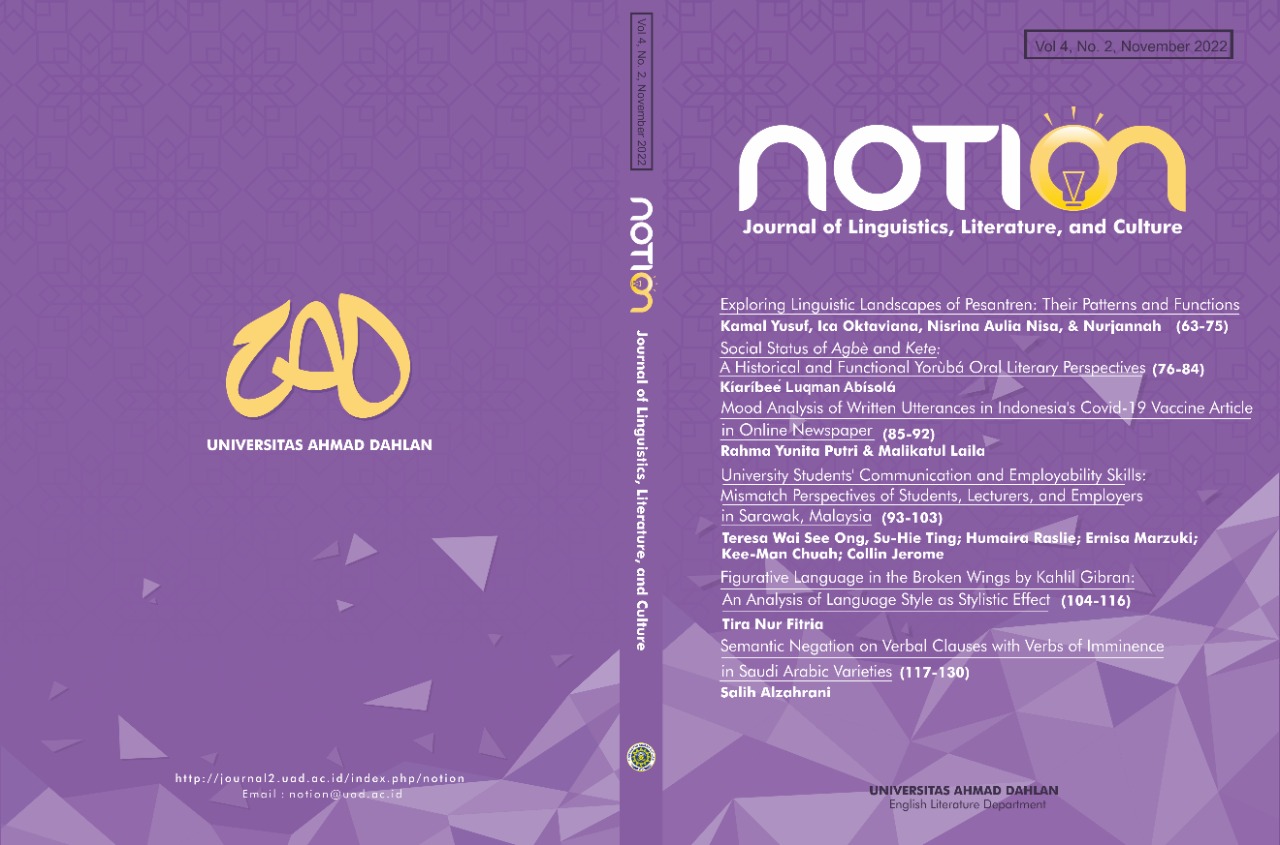Mood Analysis of Written Utterances in Indonesia’s Covid-19 Vaccine Article in Online Newspaper
DOI:
https://doi.org/10.12928/notion.v4i2.6100Keywords:
SFL, Interpersonal Meaning, MOOD Analysis, COVID-19 vaccineAbstract
This research analyze the MOOD analysis in news text about Indonesia’s covid-19 vaccine in online newspapers. The purpose of this study is to explain the formula of MOOD analysis realized in grammar and to describe the speakers' mood in the application of the MOOD analysis in Indonesia's covid-19 vaccine article from online newspaper. The main focus of this research is on descriptive text articles and MOOD structure. This type of research is descriptive qualitative, the writersors present the analysis in a description based on the relevant quality on the data and the knowledge on sfl. The data were obtained by applying the theory of Gerot and Wignell (1994). The results of data analysis from six texts, in the formula there are five types of relations between the speakers and its related finite. Such as Subject + Finite (Tense), Subject + Finite (Do), Subject + Finite (Modal), Subject + Finite (Have) and Subject + Until (To be). The most commonly category that used in the online newspaper article is Finite (Tense). In the mood of the speaker, it is found that the speaker expresses certainty, possibility, uncertainty, obligation and advice. What most of the speakers said was certainty. In the analysis the writers also found the grade of modality: from high, medium, and low.
References
Dhieni, N. (2005). Language Development Methods. Jakarta: Open University. http://repository.ut.ac.id/4695/1/PAUD4106-M1.pdf
Saghir, F., Qasim, H. M., Sibtain, M., & Shafi, S. (2020). ‘I have a dream’: An interpersonal metafunction analysis of Martin Luther King Jr.’s speech. Hamdard Islamicus, 43(2), pp. 432-451. https://www.ilkogretim-online.org/fulltext/218-1642961472.pdf
Adenan, F. (2001). Systemic Functional Linguistics: Meaning Carriers in Functional Grammar. Gadjah Mada University, XIII(3), pp. 221–233. https://jurnal.ugm.ac.id/jurnal-humaniora/article/view/728
Halliday, M.A.K. (1994). An Introduction to Functional Grammar 2nd Edition. Beijing: Foreign Language. http://www.uel.br/projetos/ppcat/pages/arquivos/RESOURCES/2004_HALLIDAY_MATTHIESSEN_An_Introduction_to_Functional_Grammar.pdf
Derewianka, B. M. (2011). A new grammar companion for teachers. https://ro.uow.edu.au/sspapers/215/
Gerot, L., & Wignell, P. (1994). Making sense of functional grammar: An introductory workbook. Queensland: Antipodean Educational Enterprises.
Droga, L. and S. Humphrey. (2005). Grammar and Meaning; an Introduction for Primary Teachers. New South Wales: Southwood Press.
Denzin, N. (2010). An introduction to triangulation. UNAIDS Monitoring and Evaluation Fundamentals, pp. 11-28. https://www.unaids.org/sites/default/files/sub_landing/files/10_4-Intro-to-triangulation-MEF.pdf
Kabigting, R. P. (2020). The Philippine Online News Headlines on COVID-19 Pandemic: An Interpersonal Metafunction Analysis. Journal of English Teaching, 6(3), pp. 204-211. https://eric.ed.gov/?id=EJ1273134
Nasita, D., Sugiarto, B. R., & Thoyyibah, L. (2020). The realization of interpersonal meaning on male and female students’ personal letter. JALL (Journal of Applied Linguistics and Literacy), 4(1), pp. 57-76. https://core.ac.uk/reader/304931240
Pranoto, H., Setiyadi, D., & Kuswardani, Y. (2020). An analysis of interpersonal metafunction in “a head full of dreams” Coldplay’s album of song lyrics. LINGUAMEDIA Journal, 1(2). http://dx.doi.org/10.56444/lime.v1i2.1607
Yang, H. (2017). The interpersonal metafunction analysis of Barack Obama’s inaugural address. International Journal of Languages, Literature and Linguistics, 3(1), pp. 27-31. https://doi.org/10.18178/ijlll.2017.3.1.105
Creswell, J. (2009). Research design: qualitative, quantitative, and mixed method approaches (3rd ed). California: Sage Publications. https://www.ucg.ac.me/skladiste/blog_609332/objava_105202/fajlovi/Creswell.pdf
Tur, A. P. A. & Sari, A. (2019). Reshaping the society face through the culture of horror told in Shirley Jackson’s the lottery. Notion: Journal of Linguistics, Literature, and Culture, Vol. 1(1), p. 1-7. https://doi.org/10.12928/notion.v1i1.709
Ratnasari, D., Defianty, M., & Hidayat, D. N. (2020). Interpersonal meaning analysis of Indonesian politicians’ Instagram captions. In 2nd International Conference on Islam, Science and Technology (ICONIST 2019) (pp. 222-230). Atlantis Press. https://doi.org/10.2991/assehr.k.200220.041
Nursyamsi, F., Purnama, A., & Hartono, H. (2019). Interpersonal meaning in Jokowi’s speech a case study at summit apec. The GIST, 1(1). Perspective, Praeger, Westport, conn. https://doi.org/10.53675/gist.v1i1.32
Downloads
Published
Issue
Section
License
Copyright (c) 2022 Rahma Yunita Putri, Malikatul Laila

This work is licensed under a Creative Commons Attribution 4.0 International License.
Authors who publish their articles in NOTION: journal of Linguistics, Literature, and Culture agree to the following terms:
- Authors retain the copyright and grant the journal right of first publication with the work simultaneously licensed under a Creative Commons Attribution 4.0 International License that allows others to share the work with an acknowledgement of the work's authorship and initial publication in this journal.
- Authors are able to enter into separate, additional contractual arrangements for the non-exclusive distribution of the journal's published version of the work (e.g., post it to an institutional repository or publish it in a book), with an acknowledgement of its initial publication in this journal.
- Authors are permitted and encouraged to post their work online (e.g., in institutional repositories or on their website) prior to and during the submission process, as it can lead to productive exchanges, as well as earlier and greater citation of published work.





